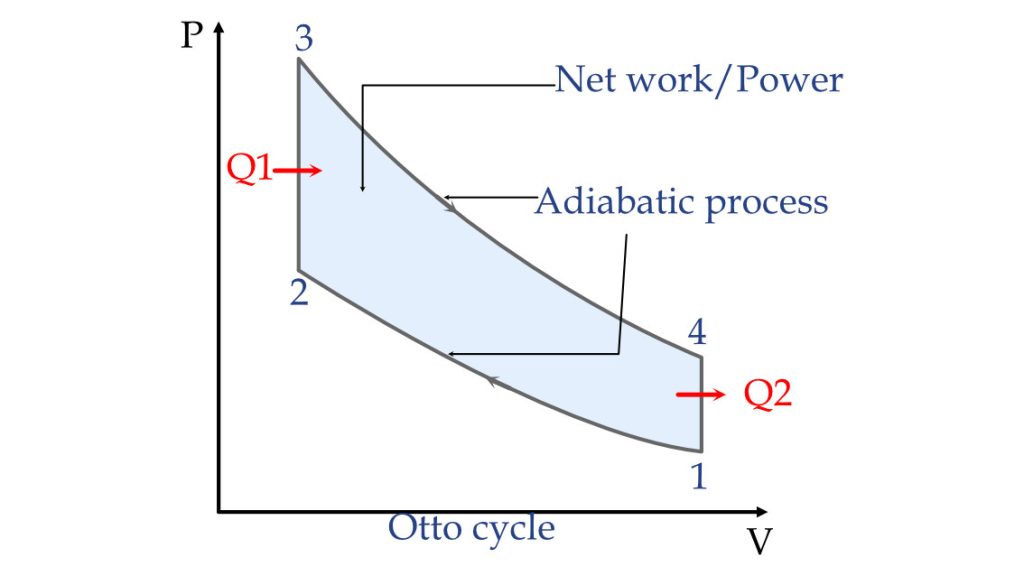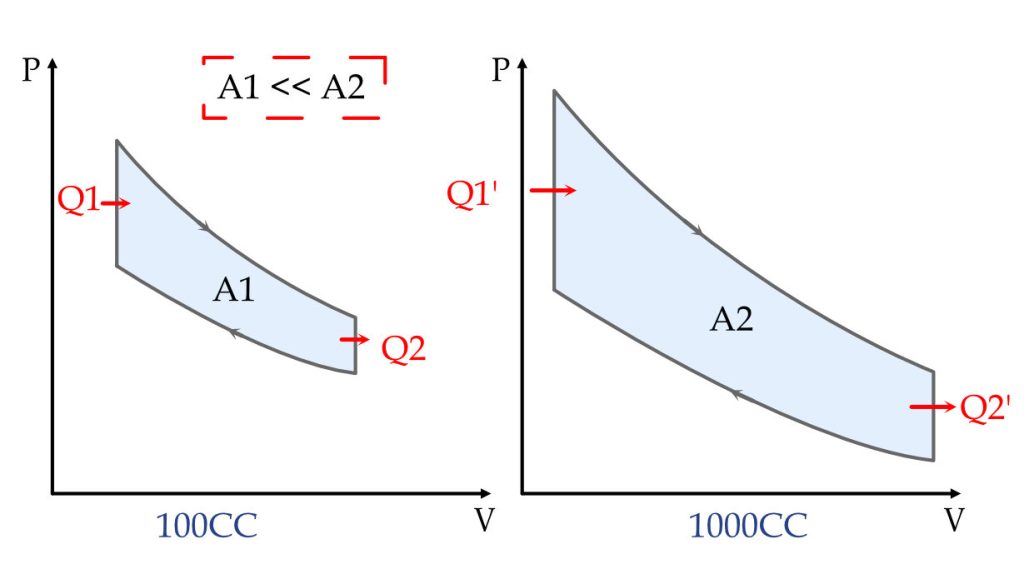Have you wondered why a 1000CC sports bike rides faster than a 100CC commuter bike? What is the factor that differentiates these two petrol-engine bikes? These questions can be beautifully answered with the help of physics behind them. Here, for this, it is the thermodynamic Otto cycle quantifies the work output and efficiencies of these engines.
In this post, you will see the Otto cycle and its relation with the petrol engine. You will also find how a 1000cc engine has more power than a 100cc engine and how to quantify its efficiencies.
Otto cycle
Whenever you talk about a petrol engine known as a spark ignition engine, you talk about the Otto cycle. Every engine works in a thermodynamic cycle; in the case of petrol engines, it’s the Otto cycle on which these engines work.
The term Otto cycle originates from Nikolaus Otto, the first petrol fuel-based internal combustion engine creator.
This is a thermodynamic process used by spark ignition engines (2-stroke or 4-stroke). The cycle comprises isochoric heat addition and heat rejection process and an isentropic expansion and compression process, as shown in the figure below.

The thermodynamic process in the cycle are:
- Isentropic compression: In the cycle, it is a constant entropy compression process (isentropic). The petrol engine is equivalent to the opening of the intake valve and flow of air-fuel mixture into the piston cylinder arrangement.
- Isochoric heat addition: The cycle is a constant volume heat addition process (isochoric). The petrol engine represents the spark ignition of an air-fuel mixture, which generates heat by burning the fuel.
- Isentropic expansion: In the Otto cycle, it is the constant entropy expansion process (isentropic). And in the engine, the expansion of gasses as a result of heat addition will move the piston down. It is the process by which the engine generates the work.
- Isochoric heat rejection: Finally, after the work is extracted from the system, the last stage is the rejection of the remaining heat from the cycle. This is the constant volume heat rejection process, in which the outlet valve will open, and the exhaust gases will go out from the piston cylinder arrangement. This is the process that produces smoke from the silencer.
Otto cycle efficiency
Now you know what the Otto cycle is, but the question of how a 1000cc engine produces more power and speed is still unanswered. To answer that, you need to see the work done and the efficiency of an engine (petrol engine) working in the Otto cycle.
The net work done in an Otto cycle equals the difference between the work generated (expansion) and the work given (compression). In the above PV graph, you can see the highlighted area representing the net work done or power output. Mathematically it is
$$W_{net} = \frac{V_f(P_4 – P_1) – V_i(P_3-P_2)}{1- \gamma}$$
And the efficiency becomes
$$\eta = 1- \frac{Q_{rejected}}{Q_{added}}$$
Or when specified in terms of compression ratio r, the total volume, and clearance volume ratio. The efficiency becomes
$$\eta= 1 – \frac{1}{r^\gamma – 1}$$
Comparison of 1000cc and 100cc petrol engine
A 1000cc engine means its volume is 1000 cubic centimeters (cc). And a 100 cc engine has one-tenth of that volume, i.e., 100 cubic centimeters (cc). If you plot the graphs in both cases, you can see that the 1000cc engine (right) has more area than 100cc (left).

So, the work, energy, or power you are getting per cycle in the case of a 1000cc engine is much higher. Because of this, the 1000cc bike can ride faster.
Conclusion
The ideology, the bigger is better, also replicates in petrol engines when dealing with engine size and power. But, to understand the actual significance of the size of the engine, the thermodynamic cycle is to be considered. It describes the working principle behind a typical petrol engine.
Some key learnings from the post:
- Otto cycle: The thermodynamic cycle on which the spark ignition engine (petrol engine) works. It comprises four processes, two isochoric and two isentropic processes.
- The efficiency of the Otto cycle: The efficiency of this cycle is a function of compression ratio, which is the ratio of total volume and clearance volume.
- 1000cc engine v/s 100cc engine: A 1000cc engine has a bigger size, so the Otto cycle of this engine will have more area. This area is directly related to net power output. Because of this, the 1000cc bike has higher power and can ride faster.

Android Apps
⭐️ ⭐️ ⭐️ ⭐️ ⭐️ 1000+ | 400,000 + Downloads (Cumulative)
At eigenplus, our goal is to teach civil engineering students about structural analysis and design starting from the fundamental principles. We do this with the help of interactive android applications and accompanying web articles and videos.
Our apps have helped more than 400 thousand students across the world to understand and learn the concepts of structural engineering. Check out our apps on the google play store.